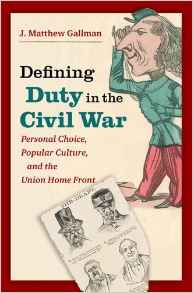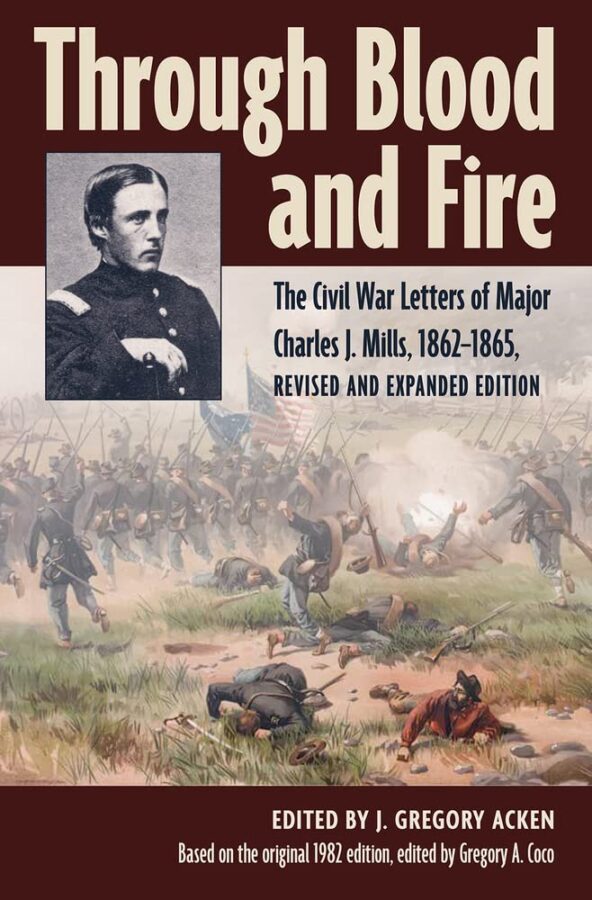Defining Duty in the Civil War: Personal Choice, Popular Culture, and the Union Home Front by J. Matthew Gallman. The University of North Carolina Press, 2015. Cloth, IBSN: 978-1469620992. $45.00.
 “One of the most difficult and delicate tasks of the statesman,” wrote Charles Janeway Stillé, “is to distinguish the factious demagogue from the grumbling but sincere patriot.” Stillé’s words come from his pamphlet, How a Free People Conduct a Long War. As historian J. Matthew Gallman observes, this tremendously popular pamphlet was but “a single contribution to a complex and multi-layered northern war culture that helped define what it meant to be a citizen of the United States in wartime” (1). Defining Duty probes this war culture and investigates printed advice “patriotic northerners sought and received during the Civil War” (1).
“One of the most difficult and delicate tasks of the statesman,” wrote Charles Janeway Stillé, “is to distinguish the factious demagogue from the grumbling but sincere patriot.” Stillé’s words come from his pamphlet, How a Free People Conduct a Long War. As historian J. Matthew Gallman observes, this tremendously popular pamphlet was but “a single contribution to a complex and multi-layered northern war culture that helped define what it meant to be a citizen of the United States in wartime” (1). Defining Duty probes this war culture and investigates printed advice “patriotic northerners sought and received during the Civil War” (1).
Gallman opens his book with three important observations. First, Northerners were not a homogenous group. He seeks to analyze “a vast body of undifferentiated northerners who remained fundamentally in favor of the Union war effort and certainly never embraced Copperheadism” (2). In essence, what made Stillé’s grumbling but sincere patriots tick? Gallman also notes that people in the United States did not know how to behave during a conflict of this magnitude. Gallman aims to “uncover how ordinary people knew how to exhibit their patriotism if they were not going to make major personal sacrifices” (3). Finally, Gallman contends that, in an effort to navigate an unknown situation, people turned to the community for guidance. This advice came from publications like Stillé’s, which “produced a set of coherent cultural messages that were absorbed by a large portion of northern society.” (20).
Defining Duty is divided into two parts. In Part I, Gallman explores three stereotypes: fools, hypocrites, and scoundrels. Newspapers quickly began mocking fools: overly zealous patriots, feckless male swells, and silly women. These fools, Gallman argues, provided citizens with a reassuring message: “the nation might be undergoing unprecedented tumult, but engaged readers—sitting at home surrounded by newspapers and journals—are playing their proper roles as part of an informed citizenry. You might be a noncombatant, the message seemed to read, but you are on solid patriotic ground because you are not an ignorant fool” (35). Thus, even if people did not know very much about military affairs, they nevertheless knew they were better than these “fools.”
Gallman’s hypocrites consist of “shoulder straps”: soldiers who boasted of their rank but never made it to the battlefield. Northerners, Gallman posits, were outraged by “the hypocrites who displayed the uniform over brandy and cigars, while never stepping into harm’s way” (70). Gallman advances the intriguing argument that “northern society seemed willing to accept that some men would choose not to enlist for various reasons” (89). Therefore, it was the dishonesty and self-aggrandizement of shoulder straps and “fake soldiers” that made them targets for satire, not their cowardice. Those men “who simply went about their own business without donning a uniform,” Gallman concludes, “seemed to attract little public scorn in the home front literature” (90).
Gallman’s third chapter discusses “shoddy contractors” and the “shoddy aristocracy.” Shoddy contractors sold rotten food, defective clothing, or faulty equipment to the government at great profit to themselves. Shoddy aristocrats also obtained their money in questionable ways, but were mocked because they had “wealth without the knowledge and taste that is supposed to accompany those riches” (103). Gallman illustrates the importance of paying attention to nativism, because northerners mocked shoddy aristocrats as poor Irish immigrants who scrambled up the social ladder far beyond the place they “should” occupy. Both shoddy types served an important function. The first type allowed legitimate contractors not to feel bad about profiting from the war. The second permitted people who had riches to feel good about themselves, because, unlike the vulgar shoddy aristocrats, they spent money to help the war effort. Duty, Gallman observes, was “defined not as avoiding wartime riches, but by spending the money wisely and patriotically” (117).
In Part II, Gallman moves from analyzing stereotypes to considering how people judged their own behavior. Gallman cautions readers to remember “notions of duty only rarely mandated specific responses” (127). Enlistment, Gallman argues, was an individual decision, and informed citizens were supposed to follow their inner guide. Satirists belittled people who invented illnesses to escape the draft. Good citizens, on the other hand, played by the rules. At least to 1863, “patriotic citizenship merely required that men examine their own circumstances and consciences and contemplate volunteering in a forthright manner” (157). Even after the passage of the Enrollment Act of 1863, Gallman contends, citizenship did not require white men to volunteer; enlistment remained an individual decision, albeit one to consider carefully. Satirists poked fun at conscripts who failed to take their chances like a man, mocking them more for hypocrisy than for cowardice. Conscription, Gallman concludes, did not eliminate free choice.
Complementing his discussion of white men, Gallman turns to white women. Concerning volunteering, white men and women received a similar message. Neither had to volunteer, either to serve in the field or as nurses, so long as they evinced a “proper patriotic spirit” and “a proper interest in, and enthusiasm for, the cause” (194). The most important role white women played in popular literature was encouraging white men to enlist. This observation is an intriguing one, particularly given the primacy war culture placed on individual choice. Gallman certainly notes that white men took into account the wishes of their friends and family. Some of the cartoons he presents, however, show strident white women pressing men into enlisting and thus overriding individual choice. Public conversation “yielded a fairly clear consensus about what the ideal patriotic woman should and should not do when faced with the war’s toughest choices, but it also left ample room for good women to fall short of those ideals, so long as her heart was in the right place” (222). In the case of both white men and women, we have to grapple with a thought-provoking dilemma. Although people needed advice on how to behave during an unprecedented crisis, the war culture seemingly abdicated responsibility for telling people how to behave and advised them to follow their consciences while being patriotic.
Gallman’s final chapter wrestles with African Americans and citizenship. Gallman charts the complexity of the debate over black enlistment and argues, “the reluctant black recruit had to be convinced that this was really his fight. And that decision, in contrast to the decisions facing white men, combined collective considerations with individual concerns” (245). Some black recruits, no doubt, had to be convinced that this was their fight. On the other hand, many African Americans—from Frederick Douglass down to fugitive slaves—understood the Civil War as an abolition war long before most white people did.
Defining Duty is a splendid book. Gallman is a shrewd historian, and that is reflected in the book’s many insights. At the same time, the book is not without certain issues. For one, Gallman might have offered more discussion of how many people read these books, pamphlets, and cartoons—and what they thought of them. In addition, Gallman admits that “this was largely a cultural conversation that emerged from, and spoke to, the North’s vast middle class” (25). Did ideas about duty and sacrifice cross class boundaries? Perhaps there is another book waiting to be written about lower class perceptions of duty and citizenship. Electoral politics are, by and large, disappointingly absent. Perhaps Gallman might have considered how politicians interacted with this war culture and advanced their own—often very different—ideas about duty, loyalty, and citizenship. To be fair, Gallman states that he wanted to avoid explicitly partisan pamphlets in favor of pamphlets like Stillé’s, because Stillé and others focused on behavior rather than belief. But political pamphlets also focused on behavior, advising Democrats how to navigate the perils of being a “loyal opposition.”
These points aside, this well-written and lively book has much to recommend it. Gallman demonstrates the richness of the topic. Hopefully scholars will build on Gallman’s findings by analyzing other groups of northerners—Copperheads and soldiers, for instance—and their perceptions of duty. Defining Duty will prove useful in upper-division undergraduate classes and graduate seminars.
Evan C. Rothera is a Ph.D. Candidate in the Department of History at The Pennsylvania State University.
